What a day! My first introduction to historical battle reenactments and all things LOCAL! First, let me begin by saying that those who planned, volunteered, and participated in this event did a wonderful job. I can only guess at the enormous preparation something like this takes.
I left the house early—at 7:30am—as I wanted to check out another site that had been on my radar since my WWII oral history lecture. I drove to Texas Point to see the remains of the defense battery, which had last been used between 1898 and 1945. The gun had since been removed and little still exists except for the cement circle mount that it once sat upon. (A quick note to anyone wishing to make the journey down to Texas Point: the road is nothing more than old crumbled bricks and cement. To take a car would be a real adventure in my opinion.)
After taking a few photos of the Sabine Lighthouse with both my regular camera and my new Sony Handycam Extended Zoom Camcorder, I headed to Dick Dowling Park. As I drove into the park, passing the flags and white tents set up by the reenactors, I found myself imagining that fateful day when Lieutenant Richard William Dowling commanded 40+ Irish dock hands to victory over a 6000-strong Federal invasion force.
I had heard bits and pieces of the story, but I had never really delved into it until I learned about my favorite actor of that time, Mrs. Kate Dorman. On this day, however, I would learn much, much more.
As I parked, I watched as, right behind me, a truck and trailer carried two canons. Another truck followed holding the wagon. Yes, I was early and the actors were setting up, but it still took me to a place that I had not been before—a hundred and forty-nine years back in history.
I walked through the grounds taking in all the sights. One thing I did learn during the day was that the passion these reenactors felt boiled over into their everyday conversations. Most of these people had family who had fought in the war. Some even had family members on both sides. And I guess that last sentence sums up the reality of what this war between brothers was, for it was indeed a family affair.
After the reenactment of the court-martial and the execution of Lt. Elijah P. Allen for desertion, the first battle took place. (Note: I have not found much information on Elijah Allen at the time of writing but will do more research into his story.) The canons roared, and the battle began. By the time the smoke had cleared, the Confederates had the upper hand, but the Federals would get their chance later in the day.
And it wasn’t just the reenactors dressing in the appropriate garb. There were a few people who showed up in dress but who were not a part of the formal festivities. One person in particular was the Woman-in-Mourning. (Note: There were three Women-in-Mourning walking around the grounds that day, but the first caught me off-guard.) As I looked back, I saw a lady dressed all in black. I couldn’t help but picture this woman to be the “Woman in Black” from the novel of the same name by Susan Hill. Fortunately she wasn’t and no harm came to the children of Sabine City, but she was creepy all the same. (Great costume!)
Speaking of ladies, there were many who dressed according to the fashion of the occasion, and I found it surreal to see them walking through the grounds or sitting near tents. I also felt for them. In 1863 it must have been bad enough enduring the elements in this area but to dress the way they did? I could not comprehend how they could stand the heat.
At 11:30 some people made their way to the statue of Richard Dowling. It was time for the memorial service. The service, hosted by the Jefferson County Historical Commission, served as a remembrance of those who died in this battle.
After the memorial service, Edward T. Cotham, author of the book Sabine Pass: The Confederacy’s Thermopylae, gave us an accurate account of what had happened on that fateful day. To hear him speak of the reality of the crews of the gunships Sachem and Clifton made me think that this day in history had been very different from the earlier skirmishes that had taken place here. Death was apparent and many lost their lives. It was certainly not on the same level as Gettysburg per se, but I believe that a life is precious whether it is one or a thousand.
Finally the time came for the Federals to face a worthy opponent. In October of 1862, a raiding party of 50 came ashore and burned the Confederate’s barracks and stables along with other structures. They confiscated steamboat Captain Dorman’s horse and wagon to transport a howitzer to use against the Rebels, but Capt. Dorman’s wife, Kate, saw what was taking place and would not stay silent as these invaders of Texas pillaged the town. Her rant to the invading army cut deep and, despite all the threats by the Federals, Kate’s hotel, which they declared they would burn to the ground, survived the raid. (Note: I apologize for the audio quality of the video of the reenactment. It would seem we were invaded by another northerner this day—a Canadian front blew in and impaired the sound.)
After the reenactment of Kate and the raiding party, another battle took place. Both sides fought bravely and fiercely, but in the end, all of the fallen would rise from the hallowed ground and prepare to fight another day. And I, of course, will be there when that day comes.
To all those who participated and put in countless hours of preparation to bring us a part of our history and heritage, I salute you. Whether you wore the blue uniform or the grey, whether you were the owner of the Catfish Hotel and cared for your brethren during the yellow fever epidemic as Kate did, you are remembered, as are the hardships you endured.

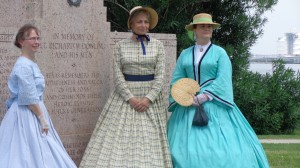
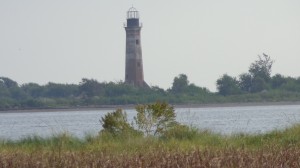
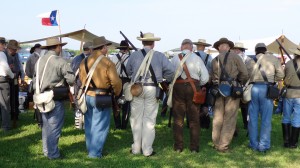
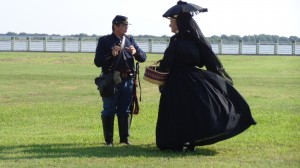
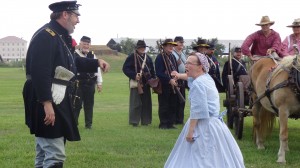
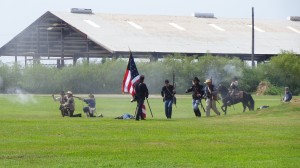
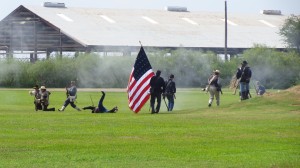
You must be logged in to post a comment.